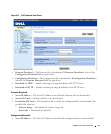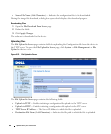
80 Update with your book title
2
Click
Show All
.
The Notification Recipients Tables page opens.
3
Select a notification recipient.
4
Check the
Remove
checkbox.
5
Click
Apply
Changes
. The recipient is deleted, and the device is updated.
Managing Files
The File Management page contains fields for managing device software, the Image Files, and the
Configuration Files. Files can be downloaded from a TFTP server.
The configuration file structure consists of the following configuration files:
•
Startup Configuration File
— Contains the commands required to reconfigure the device to the same
settings as when the device is powered down or rebooted.
•
Running Configuration File
— Contains all Startup file commands, as well as all commands entered
during the current session. After the device is powered down or rebooted, all commands stored in the
Running Configuration file are lost. During the startup process, all commands in the Startup file are
copied to the Running Configuration File and applied to the device. During the session, all new
commands entered are added to the commands existing in the Running Configuration file.
Commands are not overwritten.
•
Image File
— System file images are saved in a Flash File called an image. The device boots and runs
from the image.
To open the File Management page, click System → File Management in the tree view.
Downloading Files
The File Download From Server page contains fields for downloading system image and Configuration
files from the TFTP server or HTTP client to the device. To open the File Download From Server page,
click System → File Management → File Download in the tree view.


















